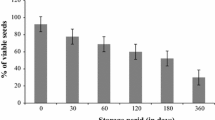Abstract
The aim of this study was to investigate the effect of pre-sowing treatments and light on Dracocephalum kotschyi Bioss. seed germination. The following treatments were used: sandpaper; 3, 5 and 10 min soaking in sulfuric acid; 15 min in sodium hypochlorite; 24 h in water, hot water and boiling water; 50, 150, and 250 mg·L−1 of Gibberellic acid; 1000, 2000, 4000, and 6000 mg·L−1 of KNO3, and water (control). The germination rate, germination start (GS), mean germination time (MGT), time to 50% germination (T50) and cumulative germination were determined as germination indices. Root, shoot and seedling length and the vigor index (VI) were evaluated as growth factors at the end of the incubation period. Second experiment was carried out to study the effect of light on seed germination. It was observed that both the physical and chemical scarification methods were effective in enhancing D. Kotschyi seed germination and growth. In the first stage, up to day 20 SA (10 min) and sandpaper scarification treated seed had shown germination more than 70% whereas control seeds did not begin germination until day 20. The highest germination rate was observed with sandpaper (1.77 units) and SA (1.56 units) in compare with other treatments (less than 0.9 units). Also the highest vigor index was found in SA- and sandpaper-treated seeds and the lowest occurred in sodium hypochlorite treatments. The other results showed that light was more effective than darkness for seed germination.
Similar content being viewed by others
Literature Cited
Amirghofran, Z., M. Azadbakht, and M.H. Karimi. 2000. Evaluation of the immunomodulatory effects of five herbal plants. J. Ethnopharmacol. 72:167–72.
Chang, Y.D., C.H. Lee, J.S. Song, and J.K. Hwang. 2009. Several factors affecting on seed germination of Dracocephalum argunense Fischer ex Link. Korean J. Plant Res. 22:236–241.
Ellis, R.H. and E.H. Roberts. 1981. The quantification of ageing and survival in orthodox seeds. Seed Sci. Technol. 9:373–409.
Gohari, A.R., S. Saeidnia, K. Matsuo, N. Uchiyama, T. Yagura, M. Ito, F. Kiuchi, and G. Honda. 2003. Flavonoid constituents of Dracocephalum kotschyi growing in Iran and their trypanocidal activity. Nat. Med. 57:250–252.
Golshani, S., F. Karamkhani, H.R. Monsef-Esfehani, and M. Abdollahi. 2004. Antinociceptive effects of the essential oil of Dracocephalum kotschyi in the mouse writhing test. J. Pharm. Pharm. Sci. 7:76–79.
Jahaniani, F., S.A. Ebrahimi, N. Rahbar-Roshandel, and M. Mahmoudian. 2005. Xanthomicrol is the main cytotoxic component of Dracocephalum kotschyii and a potential anti-cancer agent. Phytochemistry 66: 1581–1592.
Jalali, A. and Z. Jamzad. 1999. Red data book of Iran. Research Institute of Forests and Rangelands Iran, Tehran.
Kim, Y.A. and J.S. Lee. 2001. Vase life and water balance of cut rose cultivars as affected by preservative solution containing sucrose and ethionine. J. Kor. Soc. Hort. Sci. 42:325–330.
Moradi Dezfuli, P., F. Sharif-zadeh, and M. Janmohammadi. 2008. Influence of priming techniques on seed germination behavior of maize inbred lines (Zea mays L.). ARPN J. Agr. Biol. Sci. 3:22–25.
Murashige T. and F.A. Skoog. 1962. A revised medium for rapid growth and bioassays with tobacco tissue cultures. Physiol. Plant 15:473–497.
Nadjafi, F., M. Bannayan, L. Tabrizi, and M. Rastgoo. 2006. Seed germination and dormancy breaking techniques for Ferula gummosa and Teucrium polium. J. Arid Environ. 64:542–547.
Nikolaeva, M.G. 2004. On criteria to use in studies of seed evolution. Seed Sci. Res. 14:315–320.
Perez-Garcá, F. and M.E. Gonzalez-Benito. 2006. Seed germination of five Helianthemum species: Effect of temperature and presowing treatments. J. Arid Environ. 65:688–693.
Rechinger, K.H. 1986. Labiatae, p. 218–231. In: K.H. Rechinger and I.C. Hedge (eds.). Flora Iranica, Vol. 150. Akademische Druck Verlagsantalt, Graz, Austria.
Rehman, S. and I.H. Park. 2000. Effect of scarification, GA and chilling on the germination of goldenrain-tree (Koelreuteria paniculata Laxm.) seeds. Sci. Hort. 85:319–24.
Saeidnia, S., A.R. Gohari, N. Uchiyama, M. Ito, G. Honda, and F. Kiuchi. 2004. Two new monoterpene glycosides and trypanocidal terpenoids from Dracocephalum kotschyi. Chem. Pharm. Bull. 52:1249–1250.
Sajjadi, E., A.M. Movahedian Atar, and A. Yektaian. 1998. Anti-hyperlipidemic effect of hydroalcoholic extract, and polyphenolic fraction from Dracocephalum kotschyi Boiss. Pharm. Acta Helv. 73:167–170.
Takano, T. 1993. Germination Characteristics of Herbs in Labiatae. Acta Hort. 331:275–268.
Thanos, C.A., C.C. Kadis, and F. Skarou. 1995. Ecophysiology of germination in the aromatic plants thyme, savory and oregano (Labiatae). Seed Sci. Res. 5:161–170.
Thompson, P.A. 1969. Germination of species of Labiatae in response to gibberellins. Physiol. Plant 22:441–647.
Veldhuizen, V. and C. Knight. 2006. Dragonhead mint (Dracocephalum parviflorum Nutt.) as potential agronomic crop for Alaska. (AFES) Agri. Forest. Exp. Stat. 1–12.
Yücel, E. 2000. Effects of different salt (NaCl), nitrate (KNO3) and acid (H2SO4) concentrations on the germination of some Salvia species seeds. Seed Sci. Tec. 28:853–860.
Yücel, E. and G. Yilmaz. 2009. Effects of different alkaline metal salts (NaCl, KNO3), acid concentrations (H2SO4) and growth regulator (GA3) on the germination of Salvia cyanescens Boiss. Bal. Seeds GU. J. Sci. 22:23–127.
Author information
Authors and Affiliations
Corresponding author
Rights and permissions
About this article
Cite this article
Fattahi, M., Nazeri, V., Sefidkon, F. et al. The effect of pre-sowing treatments and light on seed germination of Dracocephalum kotschyi Boiss: An endangered medicinal plant in Iran. Hortic. Environ. Biotechnol. 52, 559–566 (2011). https://doi.org/10.1007/s13580-011-0057-0
Received:
Accepted:
Published:
Issue Date:
DOI: https://doi.org/10.1007/s13580-011-0057-0




